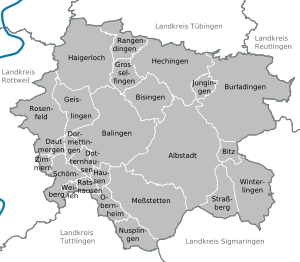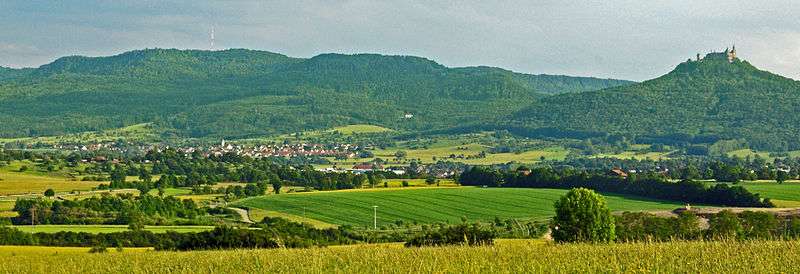Zollernalbkreis
The Zollernalbkreis is a Landkreis (district) in the middle of Baden-Württemberg, Germany. The district is located in the Swabian Alb, and contains the second highest elevation of this range, the 1,011-metre (3,317 ft) high Oberhohenberg. In the south-east the district nearly reaches to the river Danube.
Zollernalbkreis | |
|---|---|

| |
| Country | Germany |
| State | Baden-Württemberg |
| Adm. region | Tübingen |
| Capital | Balingen |
| Area | |
| • Total | 917.7 km2 (354.3 sq mi) |
| Population (31 December 2018)[1] | |
| • Total | 188,935 |
| • Density | 210/km2 (530/sq mi) |
| Time zone | UTC+01:00 (CET) |
| • Summer (DST) | UTC+02:00 (CEST) |
| Vehicle registration | BL, HCH |
| Website | www |
The district was created on January 1, 1973, when the two previous districts Balingen and Hechingen were merged.
Neighboring districts are (from north clockwise) Tübingen, Reutlingen, Sigmaringen, Tuttlingen, Rottweil and Freudenstadt.
Coat of arms

The coat of arms show the black-and-white checkered symbol of the Hohenzollern in the left half, and the triple black deer antler on yellow ground as the symbol of Württemberg. Almost all of the district's area belonged to these two states historically.
Towns (Städte) and municipalities (Gemeinden)



| Towns (Städte) | Municipalities (Gemeinden) |
|---|---|
| Verwaltungsgemeinschaften | |
|
Language
In the area of Zollernalbkreis, Swabian German is spoken. In former times, Yiddish, Pleißne and Romani was also spoken.[2] The Pleißne was spoken by hawkers selling items such as baskets, brushes, and whips, and belongs to Rotwelsch. It was used as a code.[3][4]
References
- "Bevölkerung nach Nationalität und Geschlecht am 31. Dezember 2018". Statistisches Landesamt Baden-Württemberg (in German). July 2019.
- (Stopper): Grab Josef Reinhard. In: Schwarzwälder Bote vom 28. Februar 2012.
- Werner Metzger, Schwäbischer Albverein Stuttgart (ed.), Albvereinsblätter- Festrede 125 Jahre Albverein (in German), pp. 3
- Zu Pleißne Burladingen siehe Werner Metzger: Festrede 125 Jahre Schwäbischer Albverein. In: Blätter des Schwäbischen Albvereins 2013, Stuttgart, 4. Mai 2013.